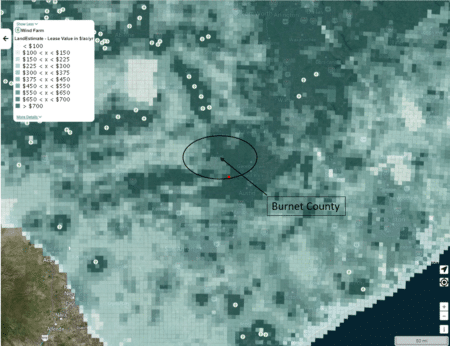Renewable Energy in Texas – Opportunity for Texas Land Owners

Introduction
According to the Texas Comptroller, Texas leads the nation in both energy production and energy consumption (https://comptroller.texas.gov/economy/fiscal-notes/2022/sep/energy.php ). Both production and consumption are expected to grow at a fairly significant rate for the foreseeable future.
It is in Texas’ best interest to have a balanced portfolio of energy generation capability. This is well recognized and significant investments are being made in the renewable energy space in order to both grow the total generation capability as well as balance the mix of generation capabilities. The two main sources of renewable energy generation are wind and solar. There is significant capital being invested in this space and the federal government, the state government and County governments are actively supporting this additional investment in wind and solar capability.
Utility scale wind and solar installations require land, generally, 30 acres to 1000+ acres. Some of the value drivers for developers include relatively flat terrain, good wind or sunshine, good drainage w/minimal floodplain and close to electrical infrastructure and road infrastructure. The electrical grid has to have the capacity to transport the energy to the end user and a wholesale buyer is needed to purchase the electricity and sell it to the end user. The current capacity and predicted future capacity of the electrical grid drives a lot of the value of a particular wind or solar installation.
The Electric Reliability Council of Texas (ERCOT) is the states electric grid operator and manages the Texas electricity infrastructure. ERCOT’s breakdown of energy use by fuel source consists of ~42% natural gas, ~24% wind, ~19% coal, ~10% nuclear, ~4% solar and ~3% other. The opportunity for landowners outside of the oil and gas producing areas of Texas is in wind and solar. Both methods require significant amounts of surface land space when constructed at a utility scale and can deliver significant revenue streams to landowners.
Solar Energy Installation in Texas
According to the Solar Energy Industry Association (SEIA) Texas currently ranks 2nd in the US with respect to total solar capacity installed and 1st in expected growth over the next 5 years.
The current solar capacity in Texas is roughly 17,000 MW. The expected growth over the next 5 years is a phenomenal 34,000 MW doubling the current capacity.
There are currently over 617 solar companies operating in Texas. A good share of these companies are actively seeking land for future utility scale installations.
Solar developer perspective:
Utility scale installations can range from as small as 30 acres up to 1,000 acres or more. The key value drivers for solar developers include the following:
- Plenty of sunshine at the installation site (solar irradiance)
- Distance to the grid and grid capacity to accept wholesale electricity near the installation
- Relatively flat terrain with minimal floodplain.
- Ease of access to the site acreage for installation and long-term maintenance
- Access to a wholesale buyer of electricity that can consistently purchase electricity
- Property and other tax impacts
What can a landowner expect if they want to consider a solar installation:
- Solar farm size range: 30 to 1,000 acres or more
- Landowner Lease payment can range from $200/acre/year to over $1,000/acre/year
- Annual escalation: 2% to 3%
- Lease term length – generally 30+ years
- Feasibility and construction time – 2 to 5 years
- Option for extension at the end of the lease
- Remediation when lease expires
Solar leases are generally confidential however for our purposes we can estimate a $/acre/year for a particular location to get a relative idea of what a solar farm lease might bring.
The figure below shows active central Texas solar installations as well as planned installations. The map is centered around Burnet County. The green shading indicates estimated relative value of a solar installation. Snapshot thanks to LandgateTM
As an example, there are some areas in Burnet County that might generate as much as $1,000/acre/year. So, a 500-acre solar farm in the right location could generate annual lease revenue to a landowner of $500,000/year.
The downside for landowners is that the solar farm will restrict other uses such as farming, grazing and recreation.
Wind Energy Installation in Texas
Wind energy is already a significant portion of Texas’ electricity generation; however, it is expected to continue to grow at a rapid rate. Current installed capacity is ~37,000 MW with an additional 4.4 MW under construction.
Wind developer perspective:
Large scale wind installations can range from as small as 500 acres up to 10,000 acres or more. The key value drivers for wind farm developers include the following:
- Plenty of wind at the installation site
- Distance to the grid and grid capacity to accept wholesale electricity near the installation
- Relatively flat terrain with minimal floodplain.
- Ease of access to the site acreage for installation and long-term maintenance
- Access to a wholesale buyer of electricity that can consistently purchase electricity
- Property and other tax impacts
What can a landowner expect if they want to consider a wind farm installation:
- Wind farm size range: 500 to 1,000 acres or more
- Landowner Lease payment range: $100/acre/year to $1,000/acre/year
- Annual escalation: 2% to 3%
- Lease term length – generally 30+ years
- Feasibility and construction time – 2 to 5 years
- Option for extension at the end of the lease
- Remediation when lease expires
Wind leases are generally confidential and can be more complex than solar leases, however for our purposes we can estimate a $/acre/year for a particular parcel to get a relative idea of what a wind farm lease might bring.
The snapshot on the next page shows active central Texas wind installations as well as planned installations. The map is centered around Burnet County. The green shading indicates estimated relative value of a wind farm installation.
Snapshot thanks to LandgateTM
Conclusion
There is significant opportunity for many central Texas landowners to monetize or create income from their land holdings by partnering with one of the many renewable energy developers that are active in Texas. TDR Real Estate is here to assist interested landowners in navigating and understanding this process. We can assist landowners in the following ways:
- Estimate a value range for installation at a particular site
- Market your property to solar and wind developers
- Lead and facilitate negotiations with developers
- Coordinate access to required expertise (technical and legal) to close a deal
- If desired, market the lease revenue stream to financial buyers to accelerate the income











